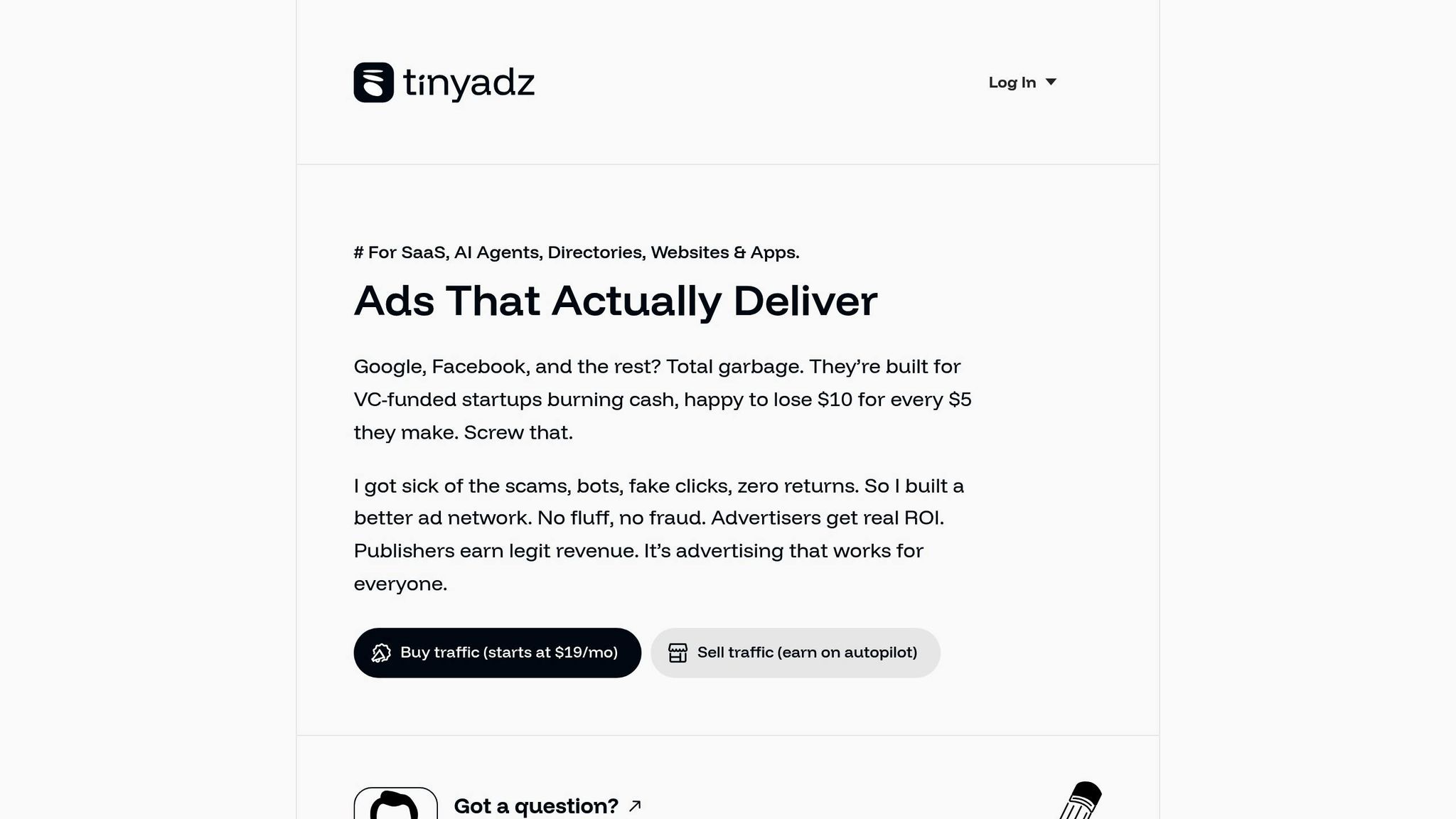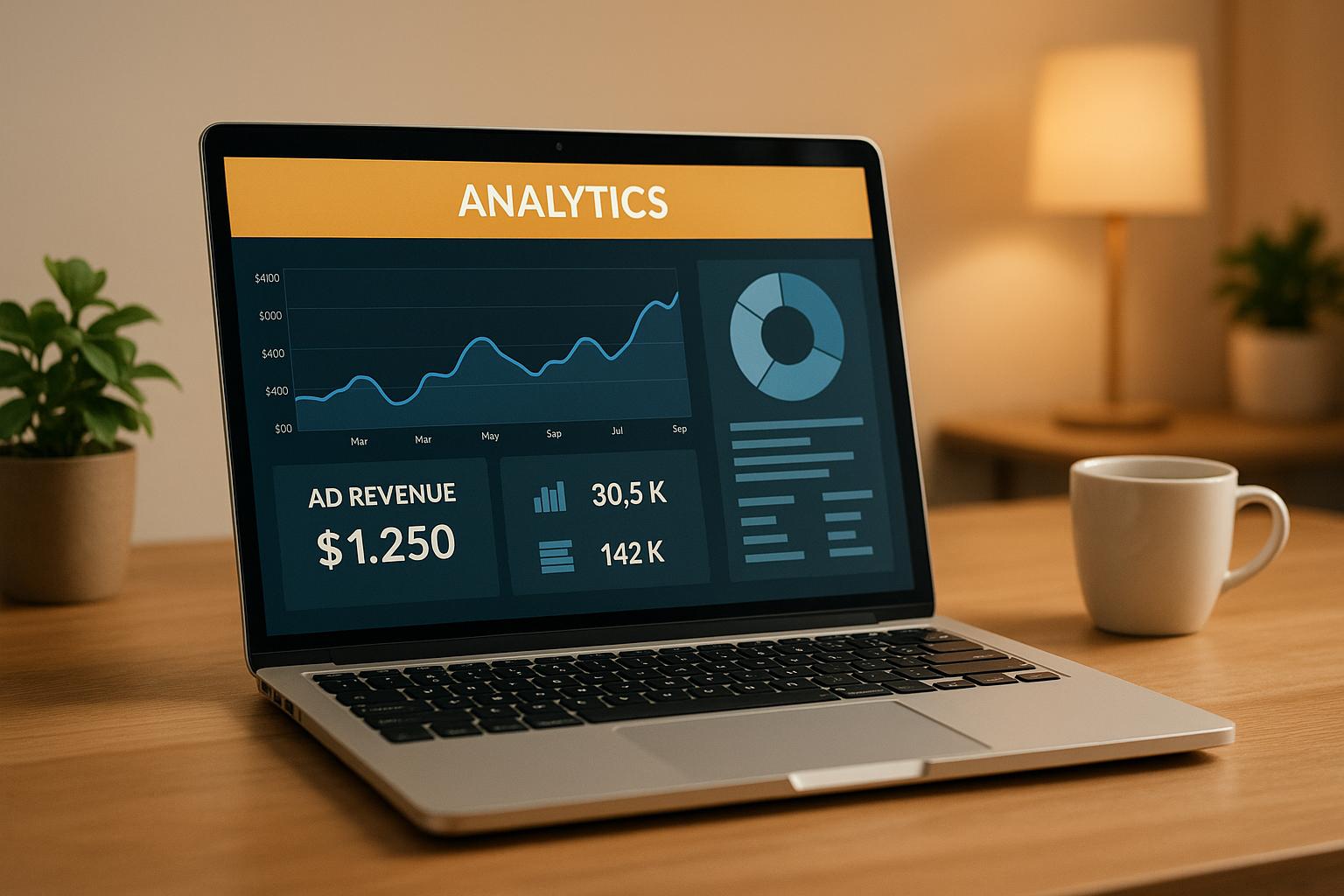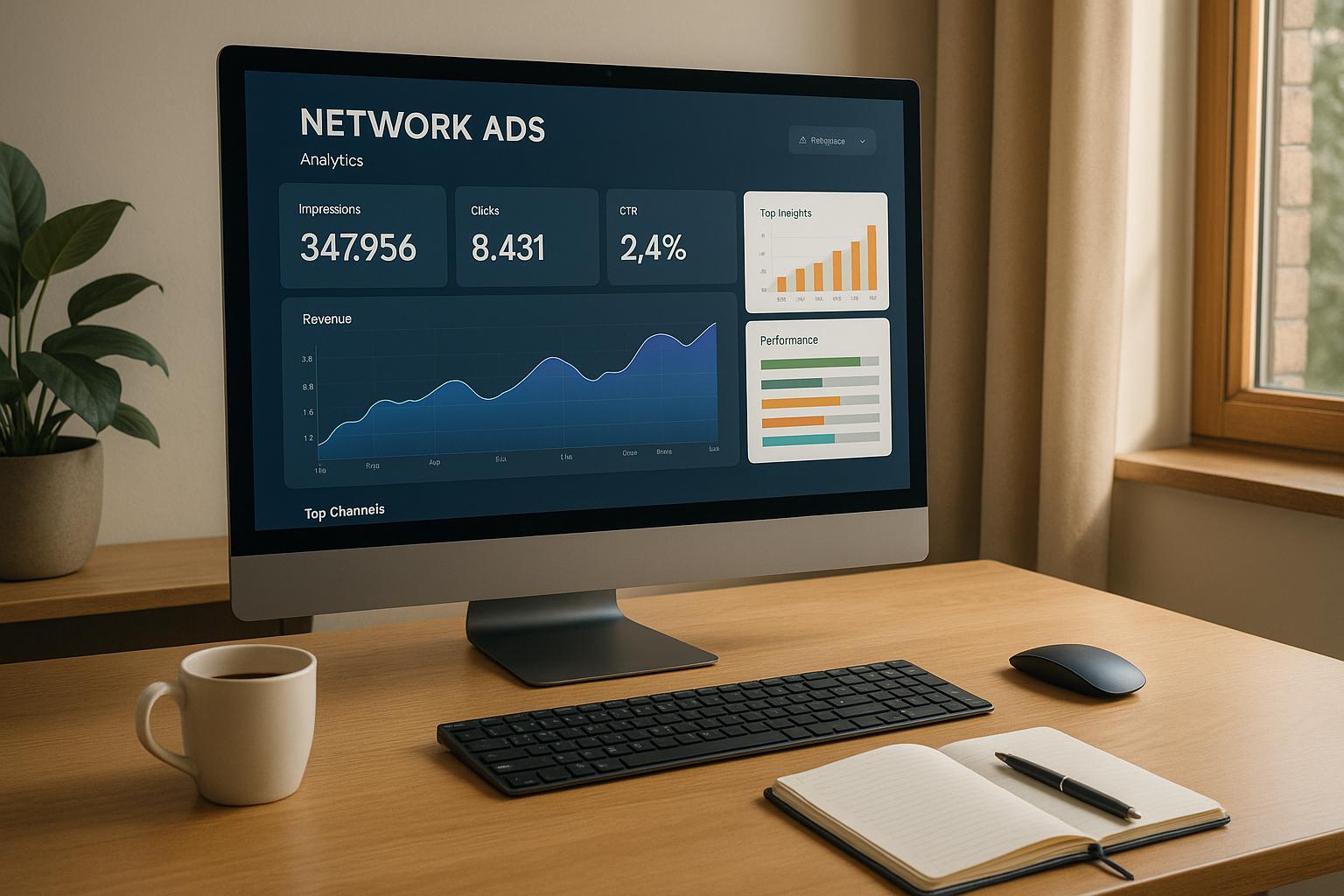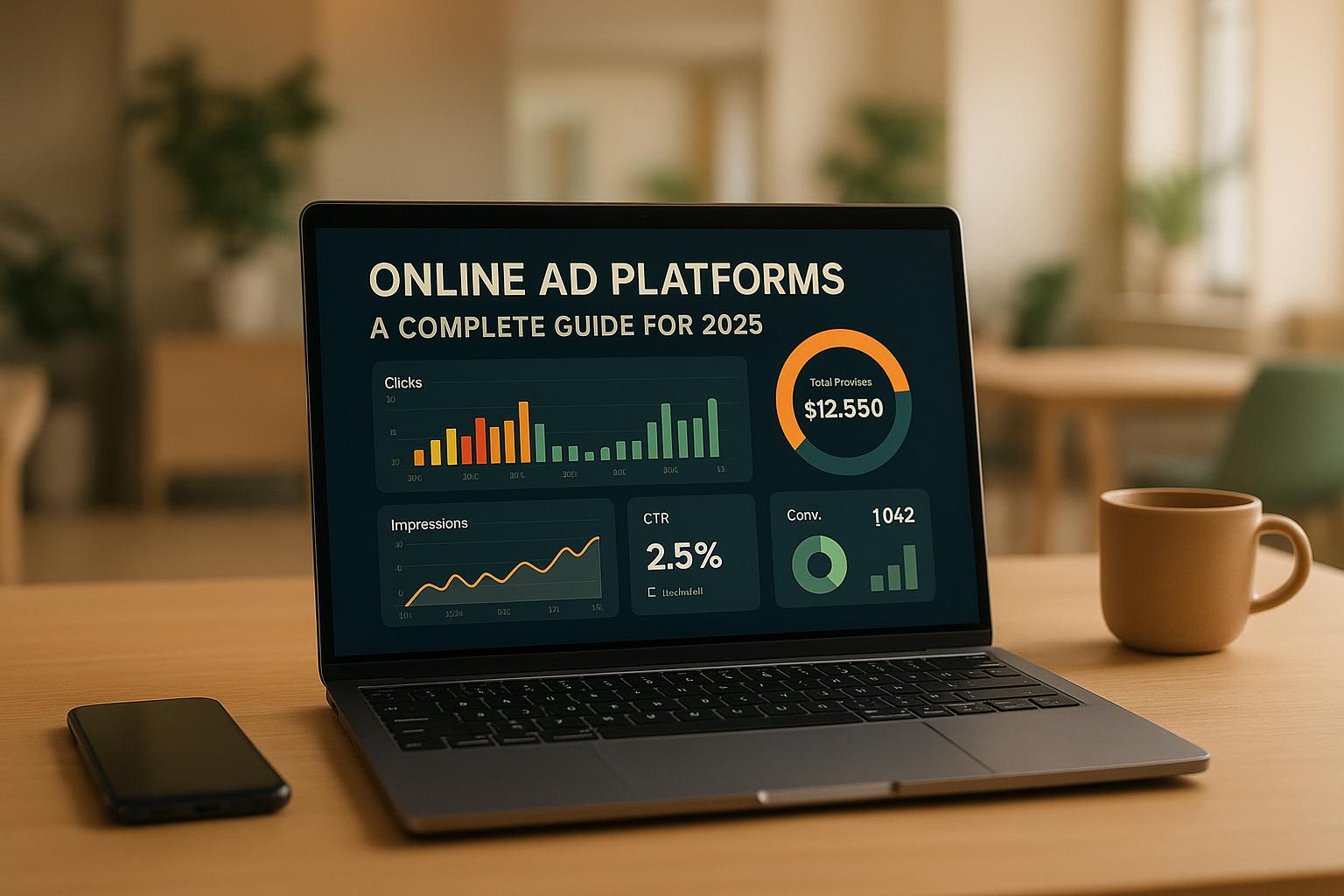Media buying in 2025 is all about automation, precision, and transparency. Here’s what you need to know:
- AI and automation dominate: Media buying platforms now use AI to automate ad placements, refine targeting, and optimize campaigns in real-time.
- Fraud prevention is critical: With $84 billion lost to ad fraud in 2023, platforms are focusing on tools like real-time verification and ads.txt to protect budgets.
- Privacy-first targeting: As third-party cookies phase out, platforms are shifting to contextual advertising and first-party data for better targeting while respecting privacy.
- Small publishers benefit: Platforms now support publishers with as few as 10,000 monthly visits, offering real revenue opportunities.
- Programmatic buying leads: By 2026, 82% of digital ad spend will be programmatic, with global ad spend hitting $726 billion.
Key takeaway: Success in media buying depends on leveraging AI-driven tools, prioritizing transparency, and embracing privacy-compliant strategies to reach the right audience effectively.
Major Trends in Media Buying for 2025
Audience Fragmentation and Targeted Campaigns
The digital landscape is more fragmented than ever, with audiences scattered across countless platforms. On average, American consumers now spend roughly eight hours a day engaging with digital media - nearly double the time they allocate to traditional media.
This shift is largely driven by the explosion of media options. Younger generations, in particular, are steering away from pay TV in favor of streaming services, social video platforms, and gaming. With on-demand content becoming the norm, advertisers are embracing data-driven strategies like audience segmentation, personalized content, and multichannel marketing. These approaches allow brands to zero in on specific audience groups while also helping niche publishers monetize highly engaged communities.
Automation and Programmatic Buying
As audience fragmentation grows, the need for precise targeting has made automation indispensable. Programmatic advertising continues to dominate, with global ad spend estimated at $595 billion in 2024 and projected to reach $800 billion by 2028. In fact, programmatic now accounts for 82.21% of digital ad spending, and ad expenditures are expected to hit $726 billion by 2026. Additionally, 83% of senior marketers are leveraging AI to refine their ad targeting efforts.
AI-powered automation enables campaigns to adjust in real time, fine-tuning placements, targeting, and budgets based on user behavior, seasonal trends, and market dynamics. For smaller advertisers and niche publishers, this technology reduces costs and removes the need for manual intervention. Advertisers can focus their budgets on impressions that meet exact criteria, while scaling campaigns across platforms and devices becomes more efficient. Tools like machine learning and dynamic creative optimization further enhance targeting accuracy and user engagement. Meanwhile, cross-platform and omnichannel strategies ensure ads are seamlessly integrated, creating a unified experience for users.
Transparency and ROI Measurement
In an era where accountability is non-negotiable, transparency in media buying has taken center stage. Marketers are demanding clearer insights into where their budgets go and the actual returns on their investments.
Data reveals that 61% of marketers plan to refine their measurement strategies using Media Mix Modeling (MMM). Channels like email marketing and PPC continue to deliver strong returns, emphasizing the importance of transparent and measurable campaigns.
However, the complexity of programmatic advertising can sometimes cloud transparency. Opaque processes and layered supply chains may obscure details about ad placements, fees, and markups. To address these concerns, privacy-first measurement is becoming the new standard, driven by consumer demands for data protection and stricter regulations. The decline of third-party cookies has accelerated the transition to first-party data and contextual advertising.
Emerging metrics like Advertising Cost of Sales (ACOS), Return on Marketing Objectives (ROMO), and Customer Lifetime Value (CLV) are providing advertisers with a clearer picture of campaign performance. These metrics capture both short-term results and long-term value, offering a more comprehensive view of effectiveness. Technologies like blockchain and advancements in cross-device and cross-channel measurement are also helping advertisers track performance more accurately. This growing transparency not only improves measurement but also fosters trust across the advertising ecosystem, paving the way for new innovations in ad technology.
[Webinar] The 2025 Playbook: Unlocking Media Buying Success
Core Features of Top Media Buying Platforms
As digital advertising continues to evolve, the best media buying platforms stand out by offering precision, adaptability, and dependability. These platforms excel in three key areas: targeted reach, diversified monetization, and transparent reporting. Let’s dive into what makes these features so essential.
Targeted Reach and Verified Traffic
Advanced targeting methods now combine demographic details, behavioral patterns, and intent-based signals to create highly specific audience segments. This level of precision is critical, especially given the ongoing concerns about ad fraud.
Leading platforms tackle these concerns with real-time fraud detection and post-campaign verification tools to filter out bot traffic. They also offer cross-channel reach, enabling advertisers to manage campaigns across search, social media, display, and video channels from one centralized dashboard. For instance, a travel agency saw a 50% increase in bookings by using an omnichannel strategy that synchronized search ads, YouTube campaigns, and Meta carousel ads.
What’s more, AI-powered tools take optimization to the next level, automatically adjusting bids, budgets, and placements in real time based on live performance data. These advanced targeting capabilities naturally pave the way for varied and effective monetization strategies.
Multiple Monetization Channels
For publishers, having access to diverse monetization options is a game-changer. The best platforms support revenue generation across multiple streams, including websites, social media, newsletters, and even live events. Technologies like header bidding and real-time bidding (RTB) allow publishers to maximize their earnings by encouraging competitive bidding for ad inventory. This ensures higher prices and better fill rates, all while keeping technical complexity to a minimum.
Flexible revenue-sharing models further enhance these platforms' appeal. For example, many established networks offer publishers a 68% share for display ads and 51% for search ads. Additionally, support for various ad formats - such as display, video, native, and dynamic ads - allows publishers to adapt their monetization strategies to meet shifting audience preferences.
Clear Reporting and Low Entry Barriers
Transparent reporting tools are essential for tracking performance and ensuring accountability. These tools provide advertisers with detailed metrics, enabling them to make informed, data-driven decisions.
Another standout feature is the low entry barrier for publishers. Many platforms eliminate minimum traffic requirements, making it easier for smaller websites to join and benefit from advanced advertising technologies. Simple setup processes, like one-click integrations or easy code snippets, further reduce technical hurdles. This accessibility empowers even small publishers to participate in and profit from the digital ad ecosystem.
Budget management tools also play a crucial role. Features like daily or lifetime spending caps, quick reallocations, and real-time adjustments give advertisers the flexibility to manage campaigns efficiently and adapt to changing needs.
How TinyAdz Serves Niche Publishers

TinyAdz is making waves in the world of niche publishing by embracing transparency and automation to optimize monetization strategies. The platform focuses on helping niche publishers generate revenue effectively, all while ensuring that campaigns connect with genuine, human audiences.
Publisher Monetization Options
TinyAdz provides niche publishers with six tailored monetization channels:
- Banner Ads: Display ads targeted to specific audiences.
- Directory Monetization: Generate revenue from resource directories.
- All-Site Traffic Solutions: Monetize every part of a website, not just the high-traffic areas.
- Social Media Monetization: Tap into active social platforms for additional income.
- Newsletter Revenue: Incorporate targeted ads into email newsletters for extra earnings.
- Event Monetization: Turn industry events, conferences, or webinars into revenue opportunities.
These options are designed to work seamlessly with TinyAdz’s precise audience-targeting capabilities.
Connecting Advertisers with Targeted Audiences
For advertisers, TinyAdz offers a direct line to highly specific audiences through personalized matchmaking, verified traffic, and clear, transparent reporting.
US Market Examples
TinyAdz’s strengths in monetization and audience targeting are particularly well-suited for the US market. Consider the booming mobile app industry: in 2023, global app downloads hit 257 billion, with revenue expected to reach $485 billion by 2024 and grow to $629 billion by 2027. This rapid growth highlights opportunities for niche publishers to focus on specialized content areas like technology, finance, and health, enabling them to command premium ad rates.
TinyAdz provides flexible ad formats and campaign options, allowing publishers to align their strategies with audience behavior. This adaptability is especially valuable in the diverse and competitive US market.
sbb-itb-957fd63
Methods to Maximize ROI and Maintain Transparency
Media buying in 2025 is all about leveraging data and maintaining transparency. Advertisers and publishers who embrace these strategies often achieve better campaign outcomes and lower costs.
Data-Based Audience Segmentation
Using first-party data to create detailed audience profiles is a game-changer. These profiles can include demographics, behaviors, and purchase histories. Laura Peterson, Marketing Strategist at Agital, emphasizes:
"Segment your first-party data and put it to work. Upload these lists to platforms like Google and Meta to create lookalike audiences or exclude existing customers from acquisition campaigns."
Audience exclusions can lead to quick wins. For example, one client reduced costs by 25% in their Meta awareness campaigns simply by excluding past site visitors.
Automation tools like Meta's Advantage+ Shopping Campaigns (ASC+) and Google's Performance Max are also reshaping targeting strategies. Case studies highlight that switching from manual targeting to ASC+ can cut cost-per-acquisition by 50%, with some clients seeing reductions of up to 32%. However, the success of these tools depends on providing high-quality inputs, such as compelling visuals and clear messaging.
Once segmentation is fine-tuned, real-time performance tracking becomes the next critical step.
Performance Tracking with Clear Metrics
Real-time tracking is essential for allocating budgets to the most effective channels. Key metrics to monitor include CPC, ROAS, CTR, and conversion rates.
Advanced attribution models can unlock deeper insights. For instance, moving to data-driven attribution in Google Ads revealed that awareness campaigns were responsible for 40% more conversions than previously thought. Testing different creatives - like static images, carousel ads, and videos - can also increase engagement by up to 20%. With real-time analytics, advertisers can continuously adjust their budgets to maintain cost efficiency.
Logan Durant explains the importance of this approach:
"There are so many parts of the customer journey to target. Our Virtuous Activity Cycle allows us to analyze performance across platforms in real time and shift budgets to where they'll deliver the most value. It's about continually refining your strategy to stay responsive to what's working."
Fraud Prevention and Platform Tools
Protecting ad spend is just as important as optimizing it. Fraud prevention measures are critical in today’s complex digital landscape, with robust strategies saving the U.S. digital advertising industry $10.8 billion in one year.
TinyAdz employs advanced verification tools and transparent reporting to ensure ads reach real audiences. Tools like ads.txt and app-ads.txt add another layer of protection by preventing domain spoofing and unauthorized inventory sales.
Supply chain transparency also plays a vital role in building trust. Real-time monitoring can help identify unusual patterns, like sudden spikes in impressions or clicks, which might indicate fraudulent activity. These measures not only safeguard budgets but also reinforce TinyAdz's dedication to delivering transparent and cost-effective campaigns.
New Tools and Technologies for 2025
The media buying world is undergoing a tech-driven transformation, bringing sharper precision, greater transparency, and better returns on investment for campaigns.
AI-Powered Targeting and Analytics
Artificial intelligence is reshaping media buying, delivering impressive results like boosting leads by up to 2,930% per month. Tools such as Warmly and Albert.ai use signal-based targeting to predict audiences ready to convert, making them especially useful for niche publishers. By analyzing user behavior patterns, these tools identify the most promising audiences for conversion.
"AI is the next step in business automation. AI had been instrumental in improving business processes. AI can be deployed to an organization's business process for a particular strategic purpose to increase efficiencies, cut costs and improve customer service." - Jasper AI
Platforms like Warmly and Albert.ai not only provide precise targeting but also offer automated cross-channel management, starting at $599 per month. For publishers focused on ad creatives, AdCreative's plans begin at $39 per month, generating high-converting designs while learning from performance data. Similarly, Madgicx optimizes Meta advertising with its AI-driven All-in-One plan, also priced at $39 per month, adjusting campaigns based on real-time audience feedback.
For publishers with limited design resources, creative generation tools like Neural.love offer affordable solutions. With a free plan and paid options starting at $11 for 100 credits, Neural.love helps maintain your brand voice while producing high-quality visuals.
Predictive audience targeting is another game-changer. By using historical data, platforms like Proxima (starting at $119 per month) help publishers focus on high-value prospects, maximizing advertising budgets and reducing waste.
Cross-Channel Attribution Tools
AI insights are also enhancing attribution models, which are now critical for evaluating campaign success. In fact, 41% of marketing organizations use attribution modeling to measure ROI.
Multi-touch attribution offers a holistic look at how different channels contribute to conversions. For publishers, moving from first-touch to time-decay attribution models can provide a clearer picture of user engagement and conversion tracking.
The secret to effective cross-channel attribution is integrating data from various sources. By combining insights from social media, email campaigns, search engines, and direct website visits, publishers can pinpoint which channels drive results and which play supporting roles.
As third-party cookies are phased out, privacy-first attribution is gaining importance. This shift encourages publishers to prioritize first- and second-party data collection, ensuring accurate attribution while respecting user privacy. Building direct audience relationships and adopting robust data strategies are now essential.
Technology Integration on TinyAdz
TinyAdz is aligning with these technological advancements to offer seamless, data-driven ad campaigns. The platform emphasizes automation with a focus on results, while maintaining user transparency and control.
To tackle the challenges of third-party cookie deprecation - highlighted as a concern by 52% of marketers - TinyAdz has adopted cookieless targeting. This includes advanced contextual targeting and integration of first-party data to ensure effective audience reach.
TinyAdz also features a unified activation system that supports cross-channel orchestration. With real-time capabilities, publishers can deliver consistent messaging across multiple platforms and make data-driven adjustments based on performance metrics and audience behavior.
PubMatic's Chief Revenue Officer, Kyle Dozeman, underscores the importance of these advancements:
"Our goal is to give media buyers a smarter, faster path to campaign performance. We've embedded Generative AI into the entire PubMatic experience, integrating the technology seamlessly into our proven tools – Activate, Connect, and our SSP – unlocking the full potential of data-driven decision-making, while bringing buyers closer to high-quality, performant supply that reaches across the breadth of the open internet." - Kyle Dozeman, Chief Revenue Officer, Americas, at PubMatic
TinyAdz is also addressing brand safety, a top concern for 60% of marketers. By implementing advanced verification systems and transparent reporting, the platform ensures ads reach authentic audiences while protecting brand reputation.
Looking ahead, TinyAdz is preparing for the rise of addressable TV advertising, with revenues expected to exceed $42 billion by 2028. This growth will unlock new opportunities for niche publishers, allowing them access to premium inventory across connected TV and streaming platforms, which were previously out of reach.
Conclusion: Media Buying Success in 2025
The media buying world in 2025 calls for a careful mix of automation, transparency, precision, and scalability. Advertisers and publishers must navigate an increasingly intricate digital space, where smaller players and niche advertisers face unique hurdles. Striking a balance between forward-thinking strategies and dependable solutions will be key to thriving in this evolving landscape.
One major challenge is combating digital ad fraud. Advertisers and publishers who choose platforms with robust fraud prevention measures, clear reporting, and strict verification processes will gain a competitive edge. Platforms like TinyAdz are stepping up to meet these demands by offering verified traffic, personalized audience matching, and flexible monetization options. Their features include multi-layered targeting, real-time optimization powered by AI and machine learning, cross-channel management from a single dashboard, and budget flexibility - all tailored to meet the needs of modern media buyers.
Privacy-compliant targeting is also taking center stage. Contextual advertising and first-party data solutions are becoming essential for reaching audiences effectively while respecting user privacy. This shift ensures advertisers can still engage their target markets without compromising trust.
For niche publishers, new opportunities are emerging. Native advertising is becoming a go-to method for content discovery, while connected TV and audio ads are gaining traction as more consumers embrace streaming platforms and podcasts. TinyAdz supports these trends by offering diverse monetization options, from banner ads and directory placements to social media and newsletter revenue streams, giving publishers the tools to adapt and grow.
To succeed, advertisers should start small - test one platform thoroughly, define clear goals, and focus on high-intent audiences. By carefully expanding their approach, they can make the most of their budgets and achieve measurable results.
In 2025, success in media buying will hinge on more than just having the latest tools. It will require selecting platforms that blend advanced technology with genuine transparency and strong support for publishers. Those who embrace AI-driven automation, maintain control over their campaigns, prioritize verified traffic, and diversify their monetization strategies will be best positioned to thrive in this dynamic environment.
FAQs
How are media buying platforms adapting to privacy changes with the end of third-party cookies?
Media buying platforms are shifting toward privacy-first strategies as the era of third-party cookies comes to an end. To keep ad targeting effective while prioritizing user privacy, they are tapping into first-party data, contextual advertising, and predictive modeling.
In response to stricter privacy regulations, many platforms are also turning to universal IDs and anonymized data solutions. These approaches allow advertisers to run personalized and impactful campaigns while maintaining transparency and safeguarding consumer trust.
What AI tools can help optimize ad placements and targeting in real time?
How AI Is Changing Ad Optimization
AI-powered tools are reshaping the way advertisers manage ad placements and targeting. By leveraging advanced algorithms, these tools can analyze massive amounts of data, automate testing, and make real-time adjustments to campaigns. The result? Ads that perform better and adapt quickly to changing conditions.
Some of the most popular AI tools focus on refining audience targeting, improving the effectiveness of ad creatives, and boosting ROI. These platforms continuously learn from campaign data, helping advertisers make smarter decisions. With AI, brands can deliver highly personalized ads to the right people at the perfect moment, keeping them ahead in a competitive market.
How can small publishers with limited website traffic succeed using modern media buying platforms?
Small publishers with modest traffic levels can still succeed by leveraging modern media buying platforms. These platforms utilize programmatic advertising, which simplifies the ad placement process and enhances audience targeting. By tapping into premium ad inventory, even smaller publishers can ensure their content reaches the right audience, regardless of traffic volume.
On top of that, tools powered by AI-driven optimization take ad performance to the next level. They help boost ROI and make campaigns more budget-friendly, all while requiring very little manual input. This means small publishers can make the most of their resources and see better outcomes without stretching themselves thin.


